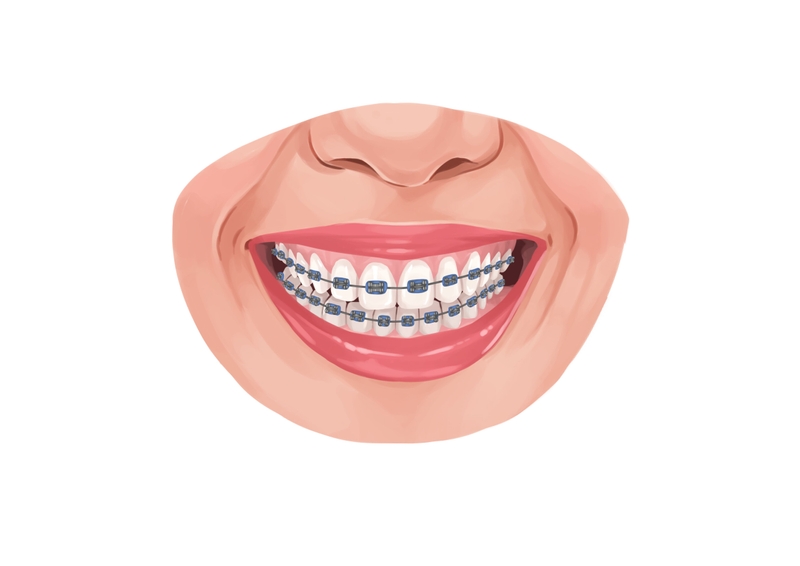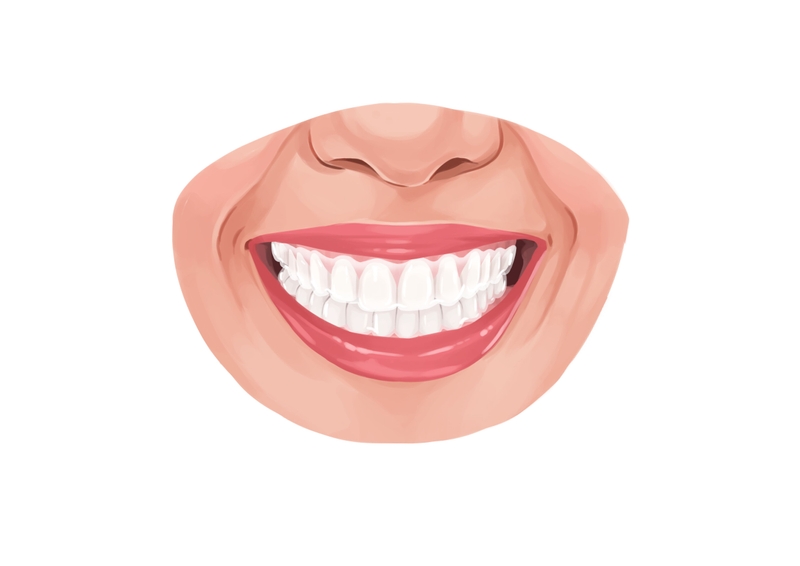- Retainers help patients to maintain the effect of braces treatment. They prevent the teeth from returning to their original position.
- Hawley retainers are durable and adjustable, but visible and bulky. Clear plastic retainers are the most comfortable and almost invisible, but can increase the risk of tooth decay
- Permanent retainers can make oral hygiene more difficult.
A perfect smile doesn't have to cost a fortune. Use Authority Dental to find affordable dental services nearby. It’s easy, fast and free.
What do retainers do for teeth? Here's everything you need to know.
Why do you need a retainer after braces?

Picture by Authority Dental under CC 2.0 license
Teeth are connected to a jaw bone by elastic ligaments, which allow correcting their position in the first place. Once the braces are off, ligaments tend to go back toward where they were before. Initially, gums and bones are not strong enough to hold the teeth in the new place. Retainer serves as external support until the tissues harden up.
After the change of position, your pearly whites never stop moving. However, the process can significantly slow down. With time, eating and speaking make teeth “used to” the new alignment.
Retainers are needed after any teeth correction, whether it’s oral surgery, Invisalign, or traditional braces. Failing to wear the support required amount of time will cause your teeth to relapse, undermining the years of orthodontic treatment.
There are different kinds of retainers: they can be either permanent or removable. Which type is best for you, depends on your teeth condition, budget, and preferences. The orthodontist will help you make the right decision.
Below you will find descriptions, as well as pros and cons of the most common retainers’ types.
Permanent retainer
Fixed or bonded retainer consists of a solid wire, which is cemented to the inside of your newly straightened teeth. It’s invisible from the outside and does not impact your speech. Getting used to the foreign object in your mouth can take from a few days to several weeks. After that period, you will be able to forget that you have it on.
Another benefit is that you don’t need to focus on a minimum number of hours you have to wear a permanent retainer - it will surely keep your teeth in place. This is the best solution if you underwent significant bite correction and there is a high risk of relapse. The same goes for patients (mostly children) that have trouble following guidance for wearing a removable retainer.
The main disadvantage is maintaining proper hygiene, as food debris and plaque build-up tend to accumulate underneath the wire. This may increase the risk of gum disease or cavities.
Many specialists advise combining a fixed retainer with wearing a removable one during the night. Enhanced treatment helps to achieve even better results. Only a dentist can remove a fixed retainer.
Cost varies from $250 to $550 per arch. It’s the most pricey option, but also the most durable.
Not visible
Doesn’t require attention during the day
Durable
Doesn’t affect your speech
It’s hard to maintain oral hygiene
You can’t take it off by yourself
Metal parts may irritate the tongue
Hawley retainer
This removable retainer is made of an acrylic tray and metal wire that holds the teeth from the outside. It’s the most noticeable option and it’s likely to impact your speech. Despite these disadvantages, that type is very common. It’s more durable than other kinds of removable retainers and relatively comfortable for most people. You can expect it to last 5 to 10 years.
A professional can adjust Hawley if needed. It comes in handy when you don’t wear your retainer enough and your teeth move slightly. Instead of making a new one (like in the case of Essix), Hawley can be regulated to fit your changed bite. For this reason, you can sometimes have corrected minor problems just with the retainer. Ask your orthodontist about this possibility. A dentist can also repair Hawley if broken, which is not possible with clear plastic retainers.
To incentivize children to put the wires on regularly, Hawley retainers may be customized. The little patient can choose the color of the acrylic, or even a tiny toy to be molded inside. In the beginning, you should wear a Hawley retainer full time, taking it out only for eating and cleaning. With time, you won’t have to keep it on that much, but be prepared to wear it nightly indefinitely.
One tray costs between $150 and $300.
Durable
Can be adjusted or fixed
Teeth touch naturally
Visible
Might affect your speech
Can irritate the inside of your mouth
Clear plastic retainer
The most popular types here are Essix and Vivera retainers. Both of them resemble Invisalign: it’s a clear tray made of thin plastic, molded to fit the exact shape of your teeth. It’s almost invisible at the beginning but tends to get discolored over time, becoming more noticeable. Compared to other removable retainers, this one is less bulky and more comfortable. It also doesn’t affect your speech. For those reasons, many people find it easier to wear it for the expected amount of time. That means a lower risk of relapse and better overall results.
On the lower side, this shape prevents teeth from touching naturally and can trap liquids against them. The latter feature might increase the risk of cavities. Essix retainers are quite delicate, prone to breaking or warping under heat. Unlike metal ones, this cannot be repaired in such a case. Clear retainers last up to 3 years.
The price ranges from $100 to $300 for one tray.
Nearly invisible
Comfortable
Doesn’t affect your speech
Easy to break or deform under heat
Can’t be adjusted or repaired
Traps liquids, which may lead to cavities
Top and bottom teeth don’t touch naturally
How to clean a retainer?

Picture by Authority Dental under CC 2.0 license
Retainers sit inside your mouth for hours, so it’s important to take care of their hygiene. The cleaning method varies depending on the type of retainer.
Removable retainer
When it comes to removable ones, you should clean them daily, as soon as you take them out from your mouth. You can use a soft toothbrush (different from the one for your teeth) or a denture brush. Remember about following points:
Be very gentle. Intense scrub can gouge the surface, creating space for bacteria. Use lukewarm water. Hot water or heat will warp the plastic. Never put the retainer in dishwashers or microwaves.
Don’t clean it with toothpaste. Its slightly abrasive formula will scratch the surface. Consider mild hand or dish soap. There are also cleaning tablets available, but you should consult your choice with a dentist.
Clean the retainer case. What’s the point of thoroughly cleansing the retainer if its container is a playground for bacteria?
Be careful with soaking. That’s especially important with Hawley retainers, which metal parts can corrode. Don’t leave it in the bath for too long and avoid mixtures containing alcohol, i.e. mouthwashes.
Take it to the dentist once in a while. They can use an ultrasonic cleaner to remove bacteria and tartar build-up without damaging the retainer.
Permanent retainer
Since you cannot take it out to rinse and clean, you should pay even more attention to the hygiene of your permanent retainer. The best practice is thorough flossing your teeth and spaces around the wire. Forgetting that can lead to plaque build-up, resulting in cavities and gum disease. Use a floss threader to get the floss to areas blocked by the retainer.
Water flossers are also a great alternative. Instead of traditional floss, the device uses a small, intense stream of water to remove debris from the hard-to-reach areas. It’s very effective and easy to use, so a lot of people with braces or retainers prefer this method.
Keep up with professional dental cleanings. A dentist will remove bacteria and tartar that you couldn’t get rid of by yourself. They can also give you tips and instructions on how to better care for your retainer at home.
FAQ
FAQ
How long do you have to wear a retainer?
Can you ever stop wearing a retainer?
How much does a retainer cost?
How long does the retainer last?
Essix retainers have the shortest lifespan. They are prone to breaking or warping, and clear plastic becomes discolored over time. Usually, they need to be replaced after about 2 years. Hawley retainers can be repaired if necessary, and last 5 to 10 years.
If cared for properly, a permanent retainer can easily last a few years up to even 20 years! The main reason for replacing it is plaque and tartar build-up. Regular cleanings will help it last longer.
What are the consequences of not wearing my retainer for a month?
References
- Fixed Orthodontic Retainers: A Review
- The origin and evolution of the Hawley retainer for the effectiveness to maintain tooth position after fixed orthodontic treatment compare to vacuum-formed retainer: A systematic review of RCTs
- Vivera retainers
- The essential work of fracture of thermoplastic orthodontic retainer materials
- Effects of fixed vs removable orthodontic retainers on stability and periodontal health: 4-year follow-up of a randomized controlled trial